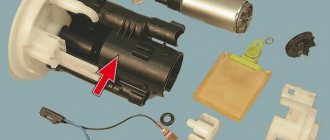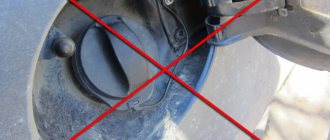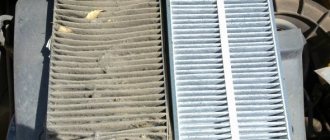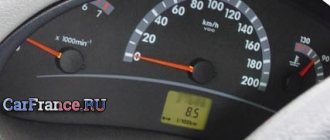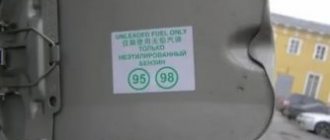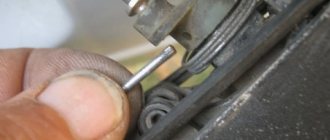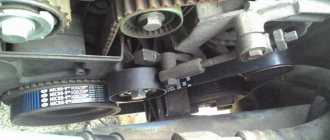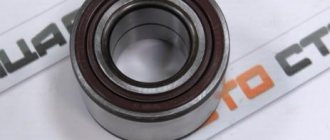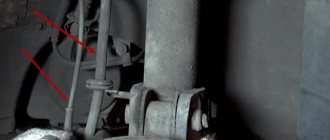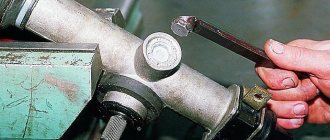Every motorist encounters unexpected situations on the road. In some cases, it is necessary to empty the fuel tank in emergency mode. Also, draining may be relevant when refueling with the wrong fuel, it may be of unsuitable quality, or for repair work.
It is not difficult to drain fuel from a car modified in the 2000s, but with new ones the situation is more difficult. In new-style cars, a protective mesh has been introduced into the gas tank, so draining will not be easy, but there are still several ways to do it.
We drain gasoline from the Lada Kalina with our own hands - why?
This article is not written for hooligan purposes. The situation is considered when low-quality gasoline is poured into a car - the engine stalls, does not pull, or the car begins to twitch suspiciously when the ignition is turned on.
The only way out of the situation is to drain the gasoline, because it is unknown what consequences driving on low-quality fuel can cause.
Drain algorithm
On the “classic”, gasoline was always drained through the neck of the tank; for Kalina (as well as for other front-wheel drive), this method is very difficult, especially if there is little gasoline in the tank.
The old-fashioned method involves draining gasoline through the neck . However, this number will not work with the first generation Kalina due to the curvature of the neck. The same applies to second-generation cars, in which the low location of the fuel tank is added to the above factor.
You can find a long silicone (transparent) hose and try to “stick” it into the neck as far as possible. If it's not cold outside, you may be able to reach the tank with a hose.
Parsing method
- There is a nipple at the end of the injector frame. We find and unscrew it.
If the hose is slightly larger than the diameter, fix it with a clamp.
Removing the fuel filter
The method is similar to the previous one, only we will drain gasoline from the fuel filter. The fuel filter is located at the bottom of the car. We remove the supply fitting, close the relay and drain the gasoline.
The arrow indicates the fuel filter.
It is necessary to turn off the fuel pump as quickly as possible, as soon as gasoline stops coming out, otherwise the fuel pump may burn out!
Removing the fuel pump
It is necessary to drain the gasoline by removing the fuel pump.
- Raise the rear sofa. We lift the carpet.
After dismantling the fuel pump, we gain free access to the contents of the fuel tank.
In addition to Kalina, these methods can also be used for Grants, since these models have the same fuel system.
Drain the fuel through the return line
If the fuel pressure regulator is located under the hood, then you do not have the newest car, but in this case you are in a better position. You can also drain gasoline through the injection line, the main thing is not to mix up the hoses. Only a primer can help here. Each car has hoses located differently.
We find the fuel pressure regulator under the hood. On it we identify the valve for the return flow of excess gasoline into the tank.
This is good, but what if the pressure regulator is in the gas tank?
Draining through a silicone tube
Ideally, a “smaller is better” straw.
Silicone bends well and can be inserted into the neck.
How to drain gasoline from a Lada Kalina tank?
Lada Kalina. How to drain gasoline from a tank
Method No. 1 If there is no mesh in the tank
Most often, there is no mesh in the tank in Russian-assembled cars. To drain the fuel, you should use a special tube; this is the most primitive, most common method.
What you will need: -hose; - a container into which we will drain gasoline.
Draining process without pump:
First of all, you need to open the gas tank by unscrewing the cap from the filler neck. Next, one end of the hose is inserted into the tank, and the second is lowered into a container into which gasoline will later need to be drained. In order for gasoline to flow, it is necessary to create pressure, and this can be done quite simply with the help of air. You just need to inhale a little air through the tube. After this, you should lower the free end into the bowl and wait until the gasoline flows.
Draining process using a pump:
You can also use a special hand pump to drain fuel for pumping out flammable liquids such as gasoline or diesel fuel. You can buy this pump at an auto store. Please note that not all hand pumps available in stores are suitable for pumping out fuel. Therefore, before purchasing a pump, make sure that it is approved for pumping fuel liquids.
Please note that once you have drained all the fuel, do not yank the hose to remove it from the tank. Firstly, you will not be able to pull out the hose this way, and secondly, you may damage the hose.
The fact is that there is a special small valve in the fuel tank that holds the fuel in the tank and prevents fuel from splashing and getting on the tank cap. That is why, once you insert the hose into the tank, it is so difficult to pull it out. This valve holds the hose. In order to remove the hose from the fuel neck (from the tank), you need to press the valve, unlocking the hose. To do this, you need to push the valve a little inside the fuel neck, and holding it in this position, pull the rubber hose out of the tank without any problems. After pulling out the hose, release the valve and close the tank with the lid.
Attention! If you use a metal screwdriver to hold the valve in the tank, be sure to ground it before you touch the valve. The fact is that if you do not ground a metal screwdriver, then upon contact with the car a microspark can form, which can easily ignite fuel vapors in the tank. It is noteworthy that if you completely drain the fuel from the gas tank, there will be enough fuel vapor in it to cause your car to catch fire
Method No. 2 If a mesh is installed in the tank
The first method is suitable only for those cars that do not have a mesh on the gas tank. If it is available, and almost all modern Japanese cars have it, then you need to do it a little differently. This method is faster and safer than the first, since with the first option there is a high probability of inhaling gasoline vapors, which can lead to poisoning by its vapors.
What we need:
-set of tools; - a canvas that can be laid on the ground; -gloves; - a container into which we will drain gasoline.
For the second option, you just need to open the cap located at the bottom of the gas tank. This is not as easy to do as it seems at first glance, because to do this you will have to get into a rather hard-to-reach place - to the bottom of the fuel tank, and only after that you need to unscrew the cap. After these manipulations, you can start draining the gasoline.
If the car is fuel injected
It is absolutely impossible to completely empty the fuel system of an injection car using a hose. Therefore, in order to drain gasoline from an injection car, you will need to take a different route. First, you should open the gas tank itself (neck), after which the algorithm of actions will be approximately as follows: - find the tube located at the bottom of the engine, supplying fuel to the ramp; - remove the clamp from it and disconnect it from the pipe; -turn the ignition key; - in the relay block, determine the one that is responsible for the fuel pump; -after removing it, you need to bridge it, for which it is convenient to use a standard paper clip; - turn on the car ignition; -drain the leaking fuel into a prepared container, then return the hoses and relays to their places. Important! Using this method of releasing the fuel system, you should carefully monitor the leaking gasoline - as soon as it “bubbles”, the ignition should be turned off immediately, which will avoid damage to the pump.
see also
Comments 11
It’s almost impossible to drain, I tried it with a thin tube and barely drained a liter (there was half a tank), now when I need to, I drain it from the ramp
twist the wire into a ball and push it down the neck, and let the fuckers drain it, but if they want to drain it, they’ll drain it anyway
Check out my article: Security fuel tank flap in Lada Kalina 2 www.drive2.ru/b/3092093/
oh, I read this or even this a long time ago =) but I don’t want to completely drill into the body
I came across a lid with a lock on a previous car, it just got stuck at a gas station on the highway, in the end I twisted its head and opened it with a screwdriver and then installed a regular one
I needed gas for another car, but I couldn’t drain it myself, no matter how hard I tried. Even a thin hose won't fit.
same crap... if you need to drain it, I drain it from the ramp by unscrewing the nipple. fuel pump, closing the contacts in the diagnostic block...
From personal experience I will say that the old-fashioned way to drain gasoline through the neck with a hose is almost impossible - over the weekend I had the pleasure of doing this exciting activity))) only with a long thin tube like from a dropper I managed to drain about half a liter with grief; I didn’t have the patience for more)) ) And this despite the fact that the tank was almost full - only one bar on the panel went out and the state showed 43 liters. Later I took a different route - I unscrewed the nipple on the fuel rail and inserted a jumper instead of the fuel pump relay - when the ignition is turned on, the fuel pump immediately starts pumping; it took no more than 2 minutes to drain 10 liters, the main thing is to stop in time)))
Ways to drain gasoline from the tank of a foreign car
If your car has a mesh installed in the gas tank, and you can’t drain the gasoline with a hose, don’t worry. There are several other simple ways to drain fuel from the gas tank of a foreign car. In any case, it is worth remembering that gasoline should only be drained from the tank in an open area, so as not to be poisoned by fuel vapors, which are very harmful to human health.
Method 1
Many modern cars have a special drain hole at the bottom of the gas tank that allows you to completely drain all the fuel from the tank. You just need to find this hole, place a suitable container under it and, unscrewing the cap, pour gasoline into it.
This method is very simple, but not all cars have drain holes, and crawling under the car is not always convenient. Therefore, we will consider another option, how to drain gasoline from the tank of a foreign car.
Method 2
In order to drain gasoline from the tank of a foreign car, you need to perform a few simple steps:
- Open the hood of your car;
- With the engine off, disconnect the fuel hose (coming from the fuel pump) at its connection to the engine.
- Place the freed end of the hose into a suitable container for draining gasoline from the tank (bottle, canister, etc.).
- Turn on the car's ignition, but DO NOT START the engine! In this case, the fuel pump will turn on for a few seconds and pump fuel. Thus, by turning the ignition on and off several times, you can drain a sufficient amount of gasoline from the fuel tank.
- After you have drained the required amount of gasoline, the fuel hose should be reconnected to the engine.
Second way
This option is more difficult. To drain the fuel, you will need to perform the following algorithm of actions:
It is not advisable to drain all gasoline using the described method, as there is a risk of damage to the fuel pump or airing of the vehicle’s fuel system. Tricks with closing contacts are performed solely at your own peril and risk.
It is necessary to monitor the flow of gasoline that comes in. If bubbles begin to appear in the liquid, this will indicate that there is not much gasoline left in the tank and it is time to finish, since this method has many risks.
After carrying out the described manipulations, it is important not to forget to return everything to its original place.
This is the only possible way for cars with fuel injection system. Deception of the fuel pump is an effective and only method.
conclusions
You should only drain gasoline in the most extreme cases, since you are interfering with the operation of the mechanism. This may be regarded by the manufacturer as a violation of warranty requirements, especially if the work was performed poorly, resulting in damage to some parts. Therefore, try to refuel only at proven gas stations, and constantly monitor the amount of fuel along the way.
Yes, I completely agree, sometimes when they fill up with gasoline, you drive 1 km away from the gas station and begin to sneeze, the traction disappears and there is practically no speed, sometimes it helps that you can fill in twice as much good gasoline at another gas station and stir it, you can go, in general, for everyone I have favorite dressings, as I noticed)
I didn’t think there would be so many problems if I had to drain all the gasoline from the tank. Although no one is insured, with our tankers.
Location of Kalina fuel filters
To replace filter elements on VAZ 1117-1119 series cars, you need to know where they are installed. The location of the parts is as follows:
- mesh bag - a trap for large particles is attached to the suction pipe of the gasoline pump, immersed in a tank of fuel;
A screen for catching large particles is located in the fuel tank along with the pump.
The fine cleaning element is hidden in a niche to the right of the tank
The location of the filter elements is the same for all modifications of Kalina and does not depend on the body type. That is, on the “station wagon” and “hatchback” you will find parts in the same places as on the “sedan”.
How to drain gasoline from a car's gas tank
If on old cars (carburetor foreign cars and some VAZ models) the draining process is relatively simple, then on new models you will need to work hard. This is due to the fact that they have a long winding channel, where it is difficult to push the hose, and a mesh installed at the filler neck, which also prevents draining.
Below we describe how to drain fuel yourself, depending on the type of gas tank and methods of fuel supply.
How to drain gasoline from a car
You need to know about these methods because... situations are different, sometimes drivers are carried to places where civilization has not reached, and fuel from the tank may be required. Therefore, it is necessary to know how to quickly and safely drain the gasoline from the tank when needed. Gasoline is also drained during fuel system repairs.
Below are methods for draining tanks without a mesh. These are mainly the following cars: VAZ, Gazelle, Niva, Volga, i.e. mostly Russian models. There is also a way to do this work on modern cars with an injector.
Old-fashioned way
Known to many drivers. You will need a canister and a hose to drain gasoline, which is inserted into the tank, after which you need to draw air from the other end of the tube using your mouth. You need to quickly suck in air from the hose and wait 2-3 seconds. Because gasoline will not flow immediately. Keep the end of the hose as close to the ground as possible and do not lift it up. When the fuel flows, the hose is inserted into the canister.
As an additional video, how to drain gasoline from a tank without getting drunk:
Using a fuel pump or return line
You can drain the fuel from the tank of a foreign car or modern cars of the VAZ family (Kalina, Granta, Vesta, Priora) using a hand pump. When purchasing, make sure that the pump can actually pump out fuel. Hand pumps come in different sizes and configurations. Those that are more expensive have an adapter and a hose. Cheap pump options do not have them, and you have to additionally purchase these devices.
It's done like this:
- The hoses are connected to each other, one end is lowered into the tank, the other into the container.
- Fuel pumping begins.
- The pump pumps until the characteristic sound of liquid approaching is heard and it flows out of the hole.
- If you need a lot of gasoline, then prepare several cans in advance.
Another method for injection machines is the use of return flow. To do this, you need to turn off the car engine and take the fuel hose, which is located behind the fuel pump. It is better to disconnect it under the hood of the car. It runs from the tank to the engine fuel rail. This is where it is more convenient to disconnect it. Its end is lowered into the canister, after which the ignition is turned on to the second position. In this case, the engine is turned off (we do not start), but the fuel pump will pump fluid as usual. After pumping the required amount of fuel, the ignition is turned off and the tube is installed in place.
On many foreign cars such as Renault Logan or Chevrolet Niva and VAZs from the 10th family, there is a special fitting in the fuel rail specifically for draining gasoline. We unscrew it and calmly drain the gasoline from the tank.
Drain gasoline through the fuel line and the plug in the tank
In some older foreign cars and carburetor cars, the fuel pump is located not in the tank itself, but near the engine. In this case, you can try to drain the fuel through the fuel line. You need to proceed according to this scheme:
- Remove the clamp and disconnect the hose leading from the tank to the fuel pump.
- Install the hose into the fuel container.
- After these actions, gasoline will flow from the gas tank.
If there is a drain plug in the car (you can find it in the operating instructions), you will have to use an overpass or drive the car to the inspection hole. The sequence of actions on how to drain gasoline from a tank is as follows:
- A large container or 5-liter canister is placed under the drain plug.
- The plug is unscrewed.
- The required amount of fuel is drained.
- The plug is twisted.
If there is no such plug, then you need to use a fuel pump. This method is much more complicated, because... you will have to disassemble the interior, sometimes cut a hole in the rear of the floor, and completely remove the fuel pump. This can be done when you need to completely drain all the gasoline from the tank and clean the system of dirt.
Precautionary measures
It is forbidden to jerk the fuel hose sharply, as it may break. When working with gasoline, you must ensure that it does not get on your clothes. It can ignite if there is a spark. This requirement is important if the driver and passengers smoke. It is strictly prohibited to light a fire or smoke while the procedure is being carried out and the container is being filled.
If the driver decides to use the old method, which is based on sucking air from a hose with his mouth, he should be aware that gasoline may accidentally get inside. There is a possibility of fuel being drawn in.
If this happens, your mouth should be rinsed well with water. To avoid this, inhale a little air through the hose, but carefully. We hold its end in our hands.
Solving a problem using a handset
A well-known and proven method is removal using a tube. This is an old “grandfather’s” method that is still relevant among car enthusiasts today. In this case, draining occurs through a tube into a volumetric container. Today, special bulb pumps are widely used to drain gasoline. With their help, you can quickly and safely drain the required amount of fuel. In appearance it resembles a device for measuring blood pressure. If you buy it in time, you can easily drain gasoline from any car, be it a Lada Priora or a Skoda Octavia.
For foreign cars with mesh
In a word, on old cars (except for new VAZs) you can pump out fuel in different ways; there is no special approach. But what about foreign cars whose tank is protected by a mesh. This does not include any hose.
First thing to do. Find a drain hole on such a car. It is located below the bottom.
It will be enough to unscrew the plug and gasoline will flow. If the drain hole is not provided on the machine, you will have to do something differently.
Here's what to do.
- Open the hood.
- Find the gasoline supply pipe.
- If the engine is running, turn it off.
- Remove the hose from the filter.
- Have a helper crank the starter.
- After turning on the pump, fuel will begin to come out of the hose under pressure.
If draining the fuel with a pump is not impressive, you can insert a bulb into the tube to pump it out. This way things will go much faster. Of course, it is better to place a wide container under the hose. In addition, if a pump pumps out gasoline, it must be given time to cool during draining (the starter must be turned off). If this is not done, the car's electronics will burn out. And most importantly, it is recommended to drain in this way in clean air or in a large room, so as not to be poisoned by gasoline vapors.
New Lada models also do not allow you to conveniently drain gasoline from the tank. The supply hoses of these cars are made curved, the fuel tank is located too low, it will not be possible to drain the fuel using the methods described above. However, there is another way.
- At the end of the nozzle rail you need to unscrew the nipple.
- Then put a hose on the rail, which at the other end is lowered into the container.
- Turn on the ignition.
If you have to pump out fuel periodically, it is easier to purchase a tube for refilling air conditioners. Such a hose can be put on the rail without unscrewing the nipple.
A few words about pumping out fuel. When the starter rotates, it supplies fuel only for a short period of time. To make it drain longer, it is recommended to install a jumper in the fuel pump relay or bridge the contacts in the BC. The last option has a plus - you don’t need to turn on the ignition, but there is also a minus - you can easily install the battery.
Methods - how to drain gasoline from a tank
Carburetor engine
If you need a small amount of gasoline, such as half a liter or a liter, and you have a carburetor engine, you can do the following. Start the engine and let it run for a while. Open the hood and locate the carburetor. Usually it is located approximately in the middle of the engine compartment and is attached to the intake manifold.
Find the fuel supply hose, it should go visually from under the bottom of the car and secured along the body, then fit onto the fuel supply fitting of the carburetor. We will need it. Do not confuse with other hoses, because one of the other hoses is the engine crankcase gas intake. Watch where they go so you don't make a mistake.
Usually the hose is put on and taken off with a simple movement without effort. But it may turn out that it is reinforced with a clamp. In this case, loosen the clamp with a screwdriver. Place the container and enjoy the process:
Having prepared a container for gasoline (for example, a plastic bottle), without turning off the engine, disconnect this hose from the carburetor. Gasoline should flow out of it. Place the container and enjoy the process. Periodically reconnect the hose back to the carburetor to fill it with a supply of gasoline and prevent the engine from stalling. Repeat these procedures until the container has the required amount of gasoline.
The gasoline that is in the carburetor chambers will not allow the engine to stall, so the engine will run for some time at idle speed. The gas pump, if it is located in the tank, will also work, so gasoline will flow out of the hose in a small stream, which is what we need.
Be careful not to let leaking gasoline get on hot parts of the engine and exhaust manifold, otherwise it may result in a fire. It’s most convenient to do this with two people - one sits in the driver’s seat with the door open, the second drains the gasoline and, if something happens, gives the command to turn off or start the engine.
After this procedure, put the hose back in place and tighten the clamp (if there was one). When starting the engine, you will most likely have to crank the starter longer so that gasoline has time to fill all the carburetor channels and enter the ignition system. Also, do not be surprised if the engine runs unstably at first and even stalls - this will pass. It just needs to work until the level of gasoline in the system is restored.
If the regulator is in the gas tank
Then you will have to do things a little differently. You can try using a standard fuel pump to pump out fuel. To do this, you simply need to disconnect the hose from the injector or fuel filter. It is advisable to carry out this entire operation on a lift or inspection pit, then you can painlessly turn off the fuel filter and lower the hose into a container. When the ignition is turned on, the standard fuel pump will pump a certain amount of fuel, but only as much as it can do in 2-3 seconds. Then you will need to turn the ignition on again, and turn it off again, and so on until the required amount of fuel is in the canister.
There is one nuance here - not all foreign cars will allow you to do this to yourself on the road. There may be complex systems for attaching hoses, difficult-to-reach places for their location, and other difficulties may arise when the fuel line is disconnected. After all, we simply may not have the right diameter hose if we're on the road. Then we use the third method. Radical.
Is it possible to drain gasoline from a viburnum?
Life has decreed that I am the proud owner of a VAZ 2107. Despite all its shortcomings due to its development more than half a century ago, the “seven” nevertheless fulfills the main task of the car - transporting people and cargo.
In addition to other shortcomings that you can somehow come to terms with or get used to, the “classic” has a very unpleasant moment - it periodically drains gasoline.
Well, really, why not drain it? The gas tank is located under the right rear fender of the car, the tank neck is very short - you can easily stick a hose there and, “sucking in”, drain almost all the gasoline into a bucket or canister. The gas tank flap does not have any locking mechanism; the standard plug also just screws on and that’s it. The alarm when opening the gas tank usually does not work. The ideal car for petrol thieves.
In modern cars, the location of the tank and filler neck is such that it is physically impossible to drain gasoline. And for the “classics” - please. So the “comrades” drive around the courtyards at night with cans, look for sleeping Zhigulis and drain gasoline from them.
I, too, became a victim of gas dumpers several times. I leave my car at night under the window, not to say in the yard - in the space between the houses, along with several neighbors. The place there is convenient - it’s far from the playground, there are few cars spending the night and everyone is familiar, the problem of dirt in the spring and after rains has been radically solved - together with a neighbor we bought a crushed stone machine and equipped a place for 5 cars. The impromptu parking lot is clearly visible from the window. But this is during the day. And on dark nights, the workers of the hose and the canister, without much difficulty or fear, quietly suck gasoline out of the sleeping “seven” like a vampire.
The first thought was, of course, a standard solution - a plug with a key, or with an eccentric, or with a combination lock. Fortunately, there are now a huge number of them on sale, from different manufacturers. Verdict - not even worth trying. All plugs are broken/twisted by experienced vampires “on time”. And inexperienced people can also ruin the paintwork around the gas tank by picking out the stubborn plug with something like a nail puller.
The idea of somehow closing the gas tank flap was immediately recognized as untenable - everything that is closed, you want to open it, pick it apart, a closed flap will only provoke criminals. The idea of welding a mesh into the gas tank so that the hose could not be inserted was also rejected; a pipe for the same purpose; set a trap or crossbow; fill the tank with methanol or diesel fuel, and use another tank as a gas tank; take gasoline home with you, etc.
You need to act simply, cheaply and within the law. Vampires with a canister are timid. It is enough to scare them just a little so that they give up their criminal plan. The simplest solution is to scare them with the existing alarm.
Attaching the “limit switch” to the gas tank was relatively easy. However, I had to replace the spring in it with another one taken out of the pen - the standard one turned out to be very tight, and the hatch did not press the limit switch in the closed position.
«
The effect was significant. Several times I even managed to see from the window a guy with a canister, running away in panic from an unexpectedly “beeping” car. But one day I again found my car without gasoline. The reason turned out to be trivial - the end switch oxidized and did not contact.
It would be necessary to install some kind of closed contact instead of the limit switch, ideally a microswitch. And then I remembered that ordinary car electric locks already have these same switches.
Attaching an electric lock to the hatch was a technical matter. The electric lock itself was located between the gas tank and the fender of the car, screwed to a bar, which in turn was fastened with standard hatch screws. A rather cunningly shaped hinge was glued to the hatch on the reverse side with epoxy; a specially curved bicycle spoke was used as a rod. Now, when the gas tank flap was opened, the electric lock rod moved and closed the internal switch, and the alarm went off.
And of course, if you already have an electric lock, it would be completely unsporting not to use it to automatically close the hatch. Otherwise, an attacker with strong nerves can open the hatch, run into the bushes, wait until the alarm goes off, and then calmly come up and drain the gasoline.
To prevent this from happening, a simple circuit was assembled with two relays and a capacitor. When voltage appeared on the siren, the capacitor was charged with the same voltage; when the voltage disappeared, the first relay released the armature, switching the charged capacitor to the winding of the second relay. The capacitor was discharged onto the winding of the second relay, as a result of which the relay contact closed for a short time. This was enough to power the electric lock motor and close the hatch.
«
Now, when the siren was turned off (by time or from the alarm key fob), the gas tank flap, if it was open, automatically closed. The next time the hatch was opened, the alarm went off again.
They stopped draining gasoline. How it was cut off. But I didn’t like the fact that my vampire friends, with a persistence worthy of better use, kept climbing towards the gas tank. The alarm went off, another shot with a canister at the ready “ran towards the pond with a changed face”, but all this fuss really prevented me from sleeping. Gasoline dumpers drove almost every day, as if to work. Moreover, I still didn’t understand whether these were the same people with leaky memories (well, the alarm goes off here, don’t let it go!) or different “brigades” of gas vampires. From time to time the leakers were gone for a week or two, and I already thought that they had finally wised up - and everything started again.
The next stage in the struggle for our own gasoline was the installation of a spotlight (500 W).
I screwed it onto the balcony and directed it to the parking lot. For automatic activation, a set of a keychain transmitter and a receiver for it, something like this, was taken. The thing is excellent, it works at a distance of about 100 meters. Having searched better, you can find a ready-made actuator with a relay output; with this relay you can directly switch the spotlight. I didn't look, I attached the output transistor and relay myself. In series with the spotlight, I installed a device for smoothly switching on the lamp, which is sold in any hardware store. In order for the lamp to turn off after some time after being turned on, I used an ATtiny24 microcontroller with a simple program. I connected the key fob through a Soviet microcircuit - a solid-state relay RKP4A with a microwave sensor from an old alarm system and placed it all under the car's headliner.
Now, when someone approaches the car, the spotlight turns on. At night, in complete silence and darkness, this apparently has the desired effect on people with bad intentions. At least there are fewer leakers. The cowardly ones (and it turned out to be 80 percent of them) dropped out. It seems somehow uncomfortable to drain gasoline while standing in a bright spot in the middle of pitch darkness. You never know who can come out of this darkness, and indeed, vampires are afraid of light.
The alarm now rarely goes off. There are, of course, particularly brave leakers who, despite the spotlight, climb into the hatch. But these are reliably repelled by sound.
What else can you do? Ideally, it would be nice to catch all this evil spirits and hand them over to the police. True, I am more than skeptical about the police, but still, maybe something will work out. In order to do this, you need to install video surveillance. I still think someday I’ll buy a recorder like this one, a video camera like this one, a second video camera with a radio channel (install it in the car so that the face can be clearly seen), a hard drive and a monitor - that’s what it is. Then it will be possible to receive video recordings of attempts to drain gasoline. Record the license plate numbers of the cars in which the plumbers arrive. If you're lucky, take a photo of their faces. Write a statement to the police, re-certified as the police, attach all photo and video materials. And wait.
How to drain gasoline from a Kalina station wagon
It looks like the gasoline was drained at night, because... the hatch was open, and there were 9 liters in the tank. Is there some kind of inexpensive cap with a lock for the Lada gas tank, so that it has a valve like the standard one? I found some Ashika 148-00-001, but it seems to be without a valve if you look at the photo
PS: I ordered some kind of cap Automega (Dello) 140011910. With a key and valve for 152 wooden
PPS: The lid arrived, quite good quality, by the way. The keys are of course hefty =))) I screwed them right onto the tank, it screwed in much tighter than the old one, the valve is there. I liked the lid
Mileage: 43600 km
How to drain gasoline from Kalina and Granta
On a Lada Granta, you are unlikely to be able to drain gasoline the old way through the neck due to the design of the neck and the low location of the fuel tank. For the same reason, you cannot drain gasoline from the 2nd generation Lada Kalina, because... The fuel system of these cars is the same.
It will also not be possible to drain gasoline from a 1st generation Lada Kalina in the same way, because... the neck is curved.
The easiest way to drain gasoline from the latest front-wheel drive LADA cars is as follows: unscrew the nipple at the end of the injector ramp (see how to remove injectors), put a hose on the ramp, which we lower into an empty container. If you have to drain gasoline regularly, it is recommended to buy a hose for refilling household air conditioners and screw it onto the fuel rail without unscrewing the nipple.
Now you need to get the fuel pump to pump gasoline, but when you turn on the ignition it will only work for a few seconds. To keep the fuel pump running constantly, you can turn on the ignition and insert a jumper into the fuel pump relay (see mounting block). Or bridge pins 11 and 16 in the diagnostic connector (see installation of the BC), then the pump will work without the ignition on. Attention: prolonged operation of the fuel pump can drain the battery!
Another universal way to drain gasoline is to remove the fuel pump and pump out the fuel directly.
VAZ 2110/2112/2114/ 16 valves injector
The methods listed below are also suitable for those cars where there is a protective mesh in the fuel neck.
Method 1.
You need to drain gasoline on a cold engine.
Would need:
- connector for connecting to the fuel pump (sold separately) and a wire to it up to 3 meters long.
- a hose up to 3 meters long and with a diameter suitable for the fuel pump fitting.
- clamp;
- two crocodiles for connecting to the battery;
- metal canister;
- rags.
Algorithm of actions:
- Fold down the two rear seats and unscrew the fuel pump access flap.
- Disconnect the wire connector.
- Relieve pressure in the system. To do this, remove the engine protective cover. Find the special fitting (it is shown in the photo below) and release the pressure by pressing the button. To prevent fuel from spilling, place a small container with a volume of up to 0.5 liters.
- Find the gasoline supply hose on the pump; as a rule, it is single. Double return hose. Follow the arrow on the pump cover.
- By pressing the bracket, remove the fuel supply hose.
- Connect the prepared hose to the fitting and secure it with a clamp. Place its other end into the prepared container.
- Connect a pre-prepared connector to the pump by first extending its wire to 3 meters.
- Remember where the positive and negative wires are located and use alligator clips to connect them to the battery. Plus to plus, minus to minus.
- Gasoline will begin to flow into the container.
- Reverse the steps to return everything to its original position. Please note, do not rush to remove the hose from the canister. First, disconnect it from the fitting and drain the remaining gasoline.
Method 2.
Similar to the first one, only we disconnect the hose in front near the engine:
- To the right of the engine near the exhaust manifold, find the fuel supply hose. It releases easily thanks to the spring latches. The disconnect location is shown in the diagram below.
- Connect to it a pre-prepared hose at least 3 meters long. Place the other end into a metal container.
- Turn on the ignition. The pump will start working and pump out fuel. It is not recommended to start the car as the pump may fail.
About 100 - 150 ml of gasoline will drain at a time. Next, turn off the ignition and turn it on again.
Method 3.
Suitable for injection vehicles VAZ 2110, 2112, 2114, Lada Granta. We also take a hose and container.
- Remove the fuel pressure valve cap and use a regular cap to unscrew the nipple.
- Insert the hose. We lower its second end into the canister.
- Turn on the ignition. While the pump is pumping, gasoline will drain.
- We repeat the procedure until we add the required amount of fuel.
Methods 2 and 3 are not suitable for situations where you need to completely drain the gasoline. Frequently turning the ignition on and off will quickly drain the battery, and if you start the car, there is a high probability that the pump will idle and burn out.
On the Lada Granta we also find a fitting for measuring pressure, it is located in the same place as on the VAZ 2110. All operations are performed in the same way.
Alternatively, you can use the following method.
Method 4.
The hose is connected using the methods already described above or directly to the fuel rail.
We find the fuel pump relay and close the contacts on it. On 2112, 2111, 2110 the relay is located below to the right of the driver.
POPULAR WITH READERS: How to wash a car engine
Turn on the ignition. The pump will run continuously. But here it is important to know how much gasoline is in the tank in order to control the draining process and prevent the pump from burning out. The entry of air with gasoline is a signal that the ignition needs to be turned off.
In this simple way you can drain gasoline from the injectors of domestic cars.
How to drain gasoline from a Priora
By the way, do you know how else you can drain gasoline?
It happens that you need to drain gasoline from your car tank . Of course, from your car. This may be necessary if you have filled with bad gasoline, or you need to empty the fuel system. A Russian car will allow you to do this easily. You lower the tube into the tank, suck air from it until gasoline begins to flow up the tube. The main thing is not to swallow fuel.
A bulb pump works on the same principle. Everything is the same, just don’t suck anything in with your mouth - it won’t bring you joy, and progress will save you from the unpleasant taste of gasoline.
There is another way to drain gasoline from the tank . Take the laces, the same tube, tie a knot at the end of the lace, lower the rope into the tube.
It turns out to be a kind of piston like a syringe. This tube is lowered into the tank, you need to pull the cord - gasoline will start flowing up the tube. Only the cord knot will need to be pre-moistened with anything. But with foreign cars it’s a problem. There is a mesh on the tank; no hose can be pushed in there, no matter how hard you try. For such difficult cases, there are several ways to drain gasoline without unnecessary hassle.
Some cars have a special drain hole at the bottom of the tank. Just unscrew the plug and the fuel will flow on its own. If there is no such plug, open the hood, find the fuel hose, turn off the engine, remove this hose from the filter, and then ask someone to turn the starter. The fuel pump will turn on and squeeze gasoline through the hose. Or use a bulb pump here
Place the container, otherwise you will splash everything around. Don’t forget to let the pump cool down periodically - the starter must be turned off, otherwise the electronics will burn out. It is necessary to do all this in an open room, so as not to suffocate with gasoline fumes and not catch an insidious glitch.
But what about modern domestic cars, such as Lada Priora, Granta or Kalina. They, too, are not so simple with their method of draining fuel.
We drain fuel from VAZ family cars
There are several ways to drain gasoline. Fuel can be drained in the shortest possible time using a hose equipped with a bulb pump. This simple device allows the car owner to remove gasoline from the tank without harming his health. But such a device can be used if the tank does not have a protective mesh at the neck.
There is a simple but effective method. Often fuel needs to be pumped out quickly; the need catches the driver on the highway. For example, this situation arises when you need to save someone. It happens that you don’t have the necessary things with you. In this case, you can use a small diameter tube.
The procedure is similar to the one that involves using a hose:
The procedure has several disadvantages, but the main one is that it is impossible to completely empty the fuel system . The procedure becomes more complicated if it needs to be performed on a machine that came off the production line after the 90s. The fuel lines in such vehicles are tortuous.
On domestic cars, gas tanks often have plugs. They are installed so that motorists can drain fuel if necessary. To do this, the car must first be jacked up. After this, place a container of suitable volume next to it and unscrew the stopper.
When working, there is no need to rush; you should make rotational movements. Before starting the procedure, the neck of the tank is opened. This makes it possible to remove the fuel completely. The method is labor-intensive but effective.
